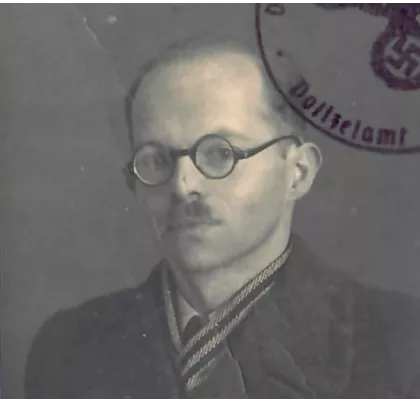Werner Falk (1908 – 1945?)
A life of escapes
- © Yad Vashem
Werner Falk was born into a Jewish family in Hanover on 21 March 1908. He and his mother Anna Karolina Falk (née Cleffmann), were deported from Berlin to Theresienstadt on the "93rd transport of the elderly" on 30 June 1943. Their last home had been in East Berlin's Samariterviertel neighbourhood at Rigaer Straße 27, in a former coal shop with a view of the courtyard. Werner lived there with his mother, his baptised sister Grete Wolters and her daughter Gisela (born 1930) - long undiscovered as Jews - in poor conditions. Werner initially worked as co-owner of a paper wholesaler and was able to remain in the business as an unskilled labourer after the repression against Jews intensified.
His niece Gisela Wolters-Sajn recounts:
„I had another uncle [Werner Falk], the son of my grandmother, as I already said, and he worked for a paper wholesaler. And apparently he owned the company with the boss. So the boss was also a colleague so to say. But, he wasn't allowed to be employed anymore as a Jew, especially not as a boss, and that is when they agreed that they would just register him as a packer in his own company. And my uncle probably provided for his family for as long as he could.“
Werner's sister Grete Wolters was repeatedly successful in concealing the Falk family's Jewish roots from the authorities. According to Gisela's report, this successful confusion tactic resulted in a relatively undisturbed life for the family. Grete was employed in a photography shop and had gained recognition as a photographer, especially among soldiers on leave from the Wehrmacht. It was only when the Gestapo became aware of the Falk family in early 1943 that Werner had to go into hiding in the cellar of his paper shop. When Anna and Werner Falk were picked up by the Gestapo towards the end of June, his sister was in hospital due to an acute attack of weakness (diagnosis: tuberculosis) and was no longer able to influence events. She had only made arrangements for the escape of her 13-year-old daughter Gisela. The adventurous descriptions of her escape, a temporary adoption by an older couple, the separate paths of mother Grete and daughter Gisela and the happy reunion with her sick mother in the winter of 1944 in a Teplitz sanatorium are a separate chapter. At the end of the war, Gisela and Grete stayed in Trnovany/ČSR with Anna Falk after the liberation of Theresienstadt.
Werner had volunteered for the Wulkow labour unit from Theresienstadt in 1944. In October 1944, he attempted to escape from Wulkow to Berlin. Apparently, he was picked up by the Gestapo, imprisoned in Schulstraße and deported to Sachsenhausen or the Small Fortress in Theresienstadt. After a meeting between the Jewish elder Benjamin Murmelstein and the commandant of the Theresienstadt ghetto Karl Rahm on 20 February 1945, following the return of the Wulkow group to the ghetto, Werner Falk was removed from the list of ghetto residents. This is where all traces of him were lost. In the meantime, his mother Anna had become very frail as a result of the worries and deprivations in the ghetto. She had also survived meningitis and had heard nothing more about her son. In-depth enquiries in 1947 by Grete Wolters (Greta Woltersová), on behalf of her mother Anna Falk, about her brother were unsuccessful.
Quote Gisela Wolters-Sajn:
„And my mother [Grete Wolters] searched for her brother. And because she asked all over town, she met a man. His name was Liewerand. And he and my uncle were transported together to the Wulkow-Zossen camp, that was a code name. He could tell her how it had been with the uncle. They had to build a barrack and the uncle wanted to escape because he probably realised, he was very close to Berlin. It is here near Berlin. And he made an attempt and then he was shaved, his head was shaved bald, and he was locked in a bunker, close to Wulkow. And then he was apparently put on the, on the, ..., they were all transported back to Terezín (Theresienstadt). They didn't want to have them near Berlin, ... because they...“
Wolters-Sajn, Gisela. Interview 32275. Visual History Archive. USC Shoah Foundation 1997. Transkript Freie Universität Berlin. 2012. Web. [05.10.2023].

